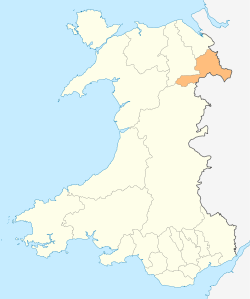Wrexham
| Wrexham | |
| Welsh: Wrecsam | |
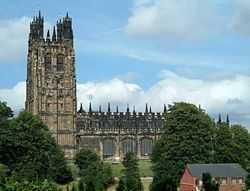 St Giles' Church, Wrexham |
|
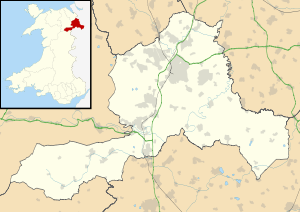 Wrexham |
|
| Population | 61,603 |
|---|---|
| OS grid reference | SJ335505 |
| Principal area | Wrexham |
| Ceremonial county | Clwyd |
| Country | Wales |
| Sovereign state | United Kingdom |
| Post town | WREXHAM |
| Postcode district | LL11—14 |
| Dialling code | 01978 |
| Police | North Wales |
| Fire | North Wales |
| Ambulance | Welsh |
| EU Parliament | Wales |
| UK Parliament | Wrexham |
| Welsh Assembly | Wrexham |
| Website | www.wrexham.gov.uk |
Coordinates: 53°02′47″N 2°59′36″W / 53.0463°N 2.9932°W
Wrexham (/ˈrɛksəm/ REKS-əm; Welsh: Wrecsam; Welsh pronunciation: [ˈwrɛksam]) is a town in the north of Wales. It is the administrative centre of the wider Wrexham County Borough, located in the east of the region. It is situated between the Welsh mountains and the lower Dee Valley alongside the border to Cheshire, England. As the largest town in the north of Wales, it is a major centre of the region's administrative, commercial, retail and educational infrastructure.
At the time of the United Kingdom Census 2011, the Wrexham locality had a population of 61,603 as defined by the Office for National Statistics, the larger urban area had a population of 65,692, the fourth-largest in Wales.
History

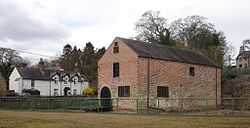
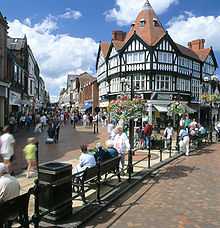
Evidence of human activity in the Wrexham area has been found as far back as approximately 1600 BC.[1] However the first known settlement was known as Wristleham Castle, a motte and bailey located in what is now known as Erddig Park, established in 1161. King Edward I of England is on record as having briefly stayed at Wrexham during his expedition to suppress the revolt of Madog ap Llywelyn in 1294. The town became part of the county of Denbighshire when it was created in 1536. Wrexham was divided into two distinct townships, Wrexham Regis (which was under the control of the King) and Wrexham Abbot (generally the older parts of the town, which originally belonged to Valle Crucis Abbey at nearby Llangollen).
In the 18th century Wrexham was known for its leather industry. There were skinners and tanners in the town. The horns from cattle were used to make such items as combs and buttons. There was also a nail-making industry in Wrexham.
In the mid-18th century Wrexham was no more than a small market town with a population of perhaps 2,000. However, in the late 18th century Wrexham grew rapidly as it became one of the pioneers of the Industrial Revolution.
The Industrial Revolution began in Wrexham in 1762 when the entrepreneur John Wilkinson (1728–1808) known as 'Iron Mad Wilkinson' opened Bersham Ironworks. Minera Lead Mines are the remains of the profitable lead industry that dates back to prehistoric times.
Wrexham gained its first newspaper in 1848. The Market Hall was built in 1848, and in 1863 a volunteer fire brigade was founded. Wrexham was also home to a large number of breweries, and tanning became one of Wrexham's main industries. In the mid 19th century Wrexham was granted borough status.
A permanent military presence was established in the town with the completion of Hightown Barracks in 1877.[2]
Wrexham's mining heritage is nearly all gone. Most former mines have been converted into industrial and business parks – one such development at Bersham Colliery has the last surviving head gear in the north Wales coalfield. Just off the A483, on the edge of Wrexham, the Gresford Disaster Memorial stands witness to the 266 miners[3] who lost their lives after a series of explosions at Gresford colliery in September 1934. In the mid to late 19th century Wrexham had over 35 breweries, and grew a proud tradition of brewing both ale and lager. In 1882 German immigrants set up Britain's first lager brewery under the name of Wrexham Lager. In 2000 the Wrexham Lager Brewery was the last one to close. A number of the original brewery buildings remain, most notably Wrexham Lager on Central Road (offices), Soames Brewery on Yorke Street (Nags Head) and Border Brewery on Tuttle Street (converted apartments). Wrexham Lager was revived in October 2011 to serve the pub trade and is now available in various pubs throughout the county.
The cemetery in Ruabon Road in Wrexham contains 40 Polish war graves. The burials of the soldiers were made in the years 1946 and 1947. The graves are under the care of the Commonwealth War Graves Commission. A memorial to the memory of the Polish armed forces and their families was erected at the entrance to the cemetery in 1989. The inscription on the memorial, in Polish, English and Welsh, reads: "In memory of the Polish soldiers and their families, for whom a return to a Free Poland was not given, who rest here and in other cemeteries in Wales". The Polish war graves are located in a special plot in the cemetery. The plot contains both Polish and Commonwealth war dead.[4]
After World War II, the former munitions factory ROF Wrexham was closed, leaving the many buildings derelict. In the 1950s British Celanese opened a large factory there followed by Firestone, Owens Corning, Kellogg's and BICC.
Wrexham at one time had a large brewing industry. The leatherworks in Petrefelin and Tuttle Street, the many coal mines in the area, the brickworks in Abenbury, Brymbo Steelworks and the breweries all closed in the latter half of the 20th century, along with some of the newer ones such as Courtalds, Firestone and Owens Corning. Wrexham was suffering from the same problems as much of industrialised Britain and saw little investment in the 1970s.
In the 1980s and 1990s funded in part by the Welsh Development Agency (WDA), a major dual carriageway (part of the A483) was built, extending the existing bypass and connecting it with nearby Chester, which in turn had connections with other big cities such as Manchester and Liverpool. A new single carriageway was also built to improve links towards Shrewsbury and Birmingham.
Wrexham's former police station on Regent Street, originally the barracks for the Royal Denbighshire Militia, is now home to Wrexham County Borough Museum. The museum has two galleries devoted to the history of the town and its surrounding communities.
A link road to the Wrexham industrial estate was completed in July 2012, at a cost of £25 million. The link road had suffered many delays due to funding problems and more recently due to local wildlife concerns.
Governance
Wrexham County Borough Council elects a mayor who serves for one year. Between 2001 and 2005 Wrexham Council's website was named the best local government portal in Wales on four occasions[5] and in 2007 was listed as 19th out of 20 in the UK's top 20 council websites based on usability, with the comment 'the leading council websites have significant scope to improve the usability of their online offering'.[6] People who live under the jurisdiction of Wrexham County Borough Council are able to pay taxes, debts and other fees through the website. They can also access many other services, such as reporting crimes, submitting planning applications and applying for permits.
The Wrexham constituency elects members to the UK Parliament and the National Assembly for Wales. The constituency includes both the town and some of its outlying villages such as Gwersyllt, Llay, Marford, Rossett and Holt. The UK Parliament constituency of Wrexham has long been a safe seat for the Labour Party. Wrexham is divided into the communities of Acton, Rhosddu, Offa and Caia Park.
Public services
Wrexham Maelor Hospital (Welsh: Ysbyty Maelor Wrecsam) is the region's major acute district hospital, with over 900 beds, and is the largest of the three core hospitals in North Wales. It is situated in the south of the town, on Croesnewydd Road. In 1985 major expansion took place on the site, modernising many of the existing departments. It was also the headquarters of the North East Wales NHS Trust, until the merger of the Local Health Boards and NHS Trusts in North Wales created the Betsi Cadwaladr University Health Board – which is the largest health organisation in Wales. Other NHS hospitals within the borough are Chirk Community and Penley Polish Hospital.
Yale Hospital (Welsh: Ysbyty Iâl), situated close to the Maelor Hospital on Wrexham Technology Park, is Wrexham's largest private hospital with over 25 beds. Formerly BUPA Yale Hospital, it is now owned and operated by Spire Healthcare.
Wrexham is served by North Wales Police; their Eastern Division HQ is in the centre of the town.
The region's main fire station is situated on Bradley Road close to the Island Green and central retail parks. Other local fire stations are located in the nearby towns of Chirk and Llangollen.
City status
Wrexham has applied for city status three times since the turn of the 21st century, in competitions to mark the new Millennium, and for both the Queen's Golden and Diamond Jubilees. In March 2012, it was announced that Wrexham had again missed out on city status as the community of St Asaph, which was often already considered as a ceremonial city, was granted city status.
In March 2012, a report was issued stating a study was under way as to whether to establish a 'city region' encompassing Wrexham, Deeside and Chester.[7]
Geography

Unusually for a large town, Wrexham is not built up alongside a major river. Instead it is situated on a relatively flat plateau between the lower Dee Valley and easternmost mountains of Wales. This situation enabled it to grow as a market town as a cross roads between England and Wales and later as an industrial hub – due to its rich natural reserves of iron ore and coal. It does however have three relatively minor rivers running through parts of the town. These are the rivers Clywedog, Gwenfro and Alyn. Wrexham is also famed for the quality of its underground water reserves, which gave rise to its previous dominance as a major brewing centre.
Originally a market town with surrounding urban villages, Wrexham is now coalesced with a number of urban villages and forms North Wales' largest conurbation including its western and south western suburban villages. The conurbation including Wrexham, Rhos, Coedpoeth and Llay built up areas totals over 100,000 residents. The Office for National Statistics defines a Wrexham Build-Up Area (Pop. 65,592 in 2011) making it the 134th largest built up area in the UK, and the 4th largest in Wales.
Wrexham is approximately 13 miles (21 km) south of Chester, 30 miles (50 km) north-west of Shrewsbury, 50 miles (80 km) south-west of Manchester, and 140 miles (230 km) north of Cardiff.
Economy
Wrexham's economy has moved away from heavy industry to high tech manufacturing, bio-technology, finance and professional services. The town also has the largest retail sector in North Wales. In 2007, the town was ranked fifth in the UK for business start-up success, higher than most larger UK towns and cities.[8]
Shopping
There are several shopping streets. A cluster of retail parks is situated around the inner ring road. Plas Coch and Berse retail parks are on the outskirts close to the A483. Central and Island Green retail parks are in the town centre. The newest development is at Eagle's Meadow. The development is connected to Yorke Street and High Street by a bridge. There are three traditional covered markets (Butter, Butchers and Peoples Markets) plus north Wales' largest open-air market. Wrexham has a Shopmobility service which is free. Much of the Wrexham town centre is pedestrianised and there are car parks.
Tourism

Wrexham held the National Eisteddfod of Wales in 2011.
A number of visitor attractions can be found in the town.
- Wales Comic Con - The largest fan-convention in Wales that brings actors, artists, writers and sports personalities to the town each year to meet thousands of fans who attend from around the globe.
- St. Giles Church – One of the Seven Wonders of Wales and burial place of Elihu Yale
- Racecourse Ground – home of Wrexham F.C. and North Wales Crusaders is the world's oldest international stadium that still continues to host international games.[9]
- Historic town centre buildings (Horse & Jockey pub – Hope Street, the Golden Lion – High Street, the Wynstay Arms Hotel – High Street & the Old Swan – Abbott Street).
- Techniquest Glyndŵr – Science discovery centre.
- Wrexham County Museum – Museum showcasing the local history.
- Saith Seren – The Welsh centre provides a bilingual environment with locally sourced food, a bar, live entertainment, meeting rooms and community facilities.
- Indoor Markets – Wrexham has always been known as a market town, and continues this tradition with 2 architecturally significant Victorian indoor markets (Butchers and General), a newer indoor market (Peoples).
Finance and Professional Services
Wrexham is home to the headquarters of the DTCC subsidiary AVOX, which collates and analyses company information for investment banks and financial organisations. At the end of 2014, AVOX employed 300 people at their Redwither Tower offices, with a plan to employ over 400 by 2016. Moneypenny is the UK's largest outsourced switchboard and personal assistant service. The company currently employs 400 people on Wrexham Technology Park and following expansion to the USA and New Zealand are currently building a new global headquarters at the Western Gateway site in the town to accommodate over 1000 employees, it is due to open in early 2016.
Bio-Technology and Materials
Wrexham Industrial Estate is home to a number of bio-pharmaceutical companies. Wockhardt, Ipsen and Cytec Industries have major sites which provide research and development and manufacturing capabilities.
Automotive and Aerospace
Wrexham's close location to both aerospace (Airbus are located in nearby Broughton) and automotive manufacturers has led to a large number of organisations being located in the town. JCB have a large transmissions and drive train site on Wrexham Industrial Estate. ACT and Magellan Aerospace also have significant sites.
Manufacturing
Large food manufacturing sites include Kelloggs, Cadbury, Calypso and Village Bakery. Electronics companies Sharp and Brother have manufacturing facilities located along the A483.
Brewing
One of Wrexham's traditional industries brewing has had a recent resurgence since 2010. Whilst only employing a small number of people Wrexham is now home to five breweries located on Wrexham Industrial Estate and the town centre. Big Hand, Erddig, Sandstone, Axiom, Wrexham Lager and Wrexham Lager Beer breweries have all come to prominence in the last few years. Wrexham Lager exports its lagers globally, with plans to expand the size of the brewery six fold by 2016.
Wrexham has held on to a substantial manufacturing base after facing stiff competition from growing eastern European and Asian economies. Approximately 25 percent of jobs in Wrexham are in the manufacturing sector, with a growing number in service, financial and technology industries.
The central area of Wrexham has also seen a number of purpose built residential developments as well as conversions of older buildings to residential use. Outside the town centre new estates are being developed in several areas, including over 500 homes at the former Brymbo Steelworks site, a ribbon of development on Mold Road leading out of the town (which includes four development companies) and Ruthin Road (Wrexham Western Gateway). There are further plans, one of which is the development of National Trust land at Erddig for over 250 homes.[10] The announcement to develop National Trust land generated many protests, particularly from residents in nearby Rhostyllen. A motion at the NT's 2008 AGM to block the development gained enough support, but was eventually overturned by a proxy vote from the NT chairman.[11]
Demography
In April 2008, the IPPR identified Wrexham as having the largest influx of Eastern European economic migrants in Wales. Between 2004 and 2007 a total of 3,430 people from these countries had registered for work in Wrexham.
Culture
Arts
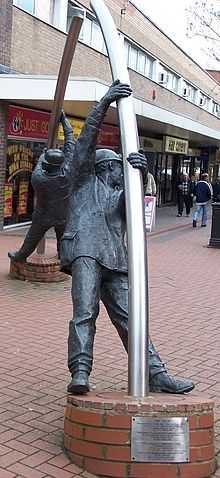
Wrexham hosted the National Eisteddfod in 1888, 1912, 1933 and 1977, as well as an unofficial National Eisteddfod event in 1876. The National Eisteddfod returned to the area in 2011, when Wales' leading festival was held on the land of Lower Berse Farm between 30 July and 6 August.
Wrexham has a number of theatres, including the Grove Park Theatre on Vicarage Hill, the Riverside Studio Theatre at Wrexham Musical Theatre Society on Salop Road, and the Yale Studio theatre close to Llwyn Isaf. Local theatre group, Tip Top Productions also present the annual Christmas Pantomime at The Stiwt Theatre in nearby Rhosllanerchrugog. The main Arts centre is at Wrexham County Library called Oriel Wrexham holding exhibitions and events, with others at Glyndŵr University in Plas Coch and Yale College. There is a multi-screen Odeon cinema in the Eagles Meadow development. The nearby town of Llangollen holds the International Musical Eisteddfod every July.
A 210-foot (64 m) sculpture called Waking the Dragon is to be built near Chirk once funding is secured.
Science
Every March the town hosts the Wrexham Science Festival. Over 9000 visitors attended events in 2007, making the event one of the biggest of its kind.
Wrexham is also home to a branch of Techniquest, known as Techniquest Glyndŵr. The science discovery centre is situated within Glyndŵr University's Plas Coch campus.
Music
Wrexham has built a vibrant music scene over the last few years. A raft of live music venues has developed around the core of the town including the largest venue Central Station, The Old Swan, Penny Black and The Commercial. Further out of the centre The Centenary Club, the William Aston Hall and The Student Guild at Glyndŵr University also provide regular live music shows. The scene is dominated by up-and-coming local bands and the town has become known as a hotbed of talent in the rock, indie and alternative genres.
The local music scene has its own dedicated website Wrexham Music which features news, forums and details of upcoming shows. The town's music scene appears regularly on national radio, in 2007 it featured on BBC Radio 1's Steve Lamacq show, and regularly features on the Welsh music portion of the station.
Most international artists perform in the larger venues of Central Station or the William Aston Hall. Central Station is also a club with a capacity of approximately 650, attracting touring bands from across the country. Since its opening in 2000 the venue has played host to hundreds of acts, including The Magic Numbers, The Kooks, Duffy, The Charlatans, Scratch Perverts, Ash, Puddle of Mudd, The Subways, Mansun, Shed Seven, The Wonder Stuff, The Damned, Skindred, Supersuckers, Wheatus, Bloc Party, Hundred Reasons, Grandmaster Flash, Electric Six, Trashlight Vision, The Fall, Budgie, The Blackout, Kids in Glass Houses, The Rifts, Rooster, Elliot Minor, Blaze Bayley, Go:Audio, Daniel Lloyd a Mr Pinc, Kill Hannah and Robert Plant.[12]
The William Aston Hall at Glyndŵr University is a 900-seat venue which has recently undergone extensive refurbishment, and is now designed to accommodate a range of events from conferences and exhibitions to theatrical performances and pop/rock concerts. Acts who have performed there in the past include Super Furry Animals, Feeder Love, Ray Davies, Freddie Starr and Sweet.[13]
Media
Wrexham's local newspapers include two daily titles, North Wales Daily Post and The Leader (formerly Wrexham Evening Leader), the weekly free Wrexham Chronicle, and the weekly broadsheet Wrexham Leader, often known as the "Big Leader". The Wrexham Music Magazine is published monthly, and concentrates on the town's large music scene.
Three radio stations are based in the town – commercial stations Heart North West and Wales (serving most of North Wales, Cheshire and the Wirral) & Heart Cymru (serving Gwynedd and Anglesey) are both broadcast from studios on Mold Road in Gwersyllt and community radio station Calon FM serves the county borough from studios at Glyndŵr University on Mold Road. BBC Cymru Wales runs a studio and newsroom for their radio, television and online services located at Glyndŵr University.
An online news website covering the Wrexham area, Wrexham.com, operates from offices at the Foundry in the town centre.
Leisure
Parks and open spaces
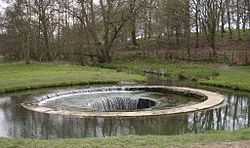
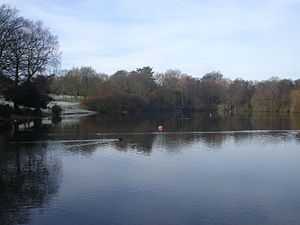
Wrexham has three parks, Bellevue Park, Acton Park, and Erddig Park with a green area within the town centre called Llwyn Isaf.
Bellevue Park was built alongside the old cemetery on Ruabon Road. The park was designed to commemorate the Jubilee year of the Incorporation of Wrexham. It became neglected during the 1970s and many of the amenities were in a poor state of repair. A major project was undertaken to refurbish the park back to its original splendour. This was funded by the Heritage Lottery Fund, Urban Parks Project, Welsh Development Agency, and the European Regional Development Fund. The park reopened in June 2000. It now boasts children's play areas, a bowling green which is home to the Parciau Bowling Club, tennis and basketball courts, an original Edwardian bandstand set in an amphitheatre, and a route for walkers and joggers. The park itself has many walkways through mature tree-lined avenues as well as affording some magnificent views of the Parish Church. The park is well lit and has a number of CCTV cameras installed to deter antisocial behaviour. Bellevue Park has once again regained its popularity with the people of Wrexham. Throughout the summer months social events take place, such as music concerts for all tastes and fun days for children.
Acton Park was originally the landscaped grounds of Acton Hall. It was laid out in 1785 by James Wyatt on the instructions of the owner Sir Foster Cunliffe. Over the years the estate passed through several owners and in 1947 Wrexham Council was given the hall and park by the then owner Alderman William Aston. A section of Acton Park was sold for housing development in the 1970s. The surviving area now covers approximately 17 hectares (42 acres). Acton Park features a bowling green, tennis courts, a children's play area, Japanese-style garden and a large lake which has attracted diverse wildlife. The general layout of the park has remained unchanged since it was laid out in the 18th century and now boasts many mature trees.
Llwyn Isaf, situated alongside Wrexham Guildhall, is a popular green area within the town centre. The green was originally the landscaped grounds of a mansion house known as Llwyn Isaf. It now lies at the centre of Wrexham's civic centre just off Queens Square. The Welsh Children in Need concert was held at this location in 2005.
Erddig Park is situated two miles (3 km) south of the town centre where the town meets the Clywedog Valley. The park is owned and managed by the National Trust, and is home to Erddig Hall and its formal gardens. The Park is also home to a number of notable historic features. These include a hydraulic ram known as the 'Cup and Saucer' which is used to pump water from the park to Erddig Hall, and the remains of Wristleham motte and bailey which is thought to be the beginnings of Wrexham as a town in the 12th century.
Sport
Football
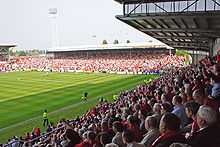
The town has a professional football team, Wrexham F.C., who were formed in 1864 – 151 years ago - making them the 3rd oldest professional football club in the world. Wrexham Play their home games at the Racecourse Ground, the world's oldest international football stadium that still hosts international matches, having hosted Wales' first ever home international match in 1877.
Wrexham compete in the English Football Conference after being relegated from League 2 in 2008, following 87 consecutive season in the Football League. Currently managed by Kevin Wilkin the club has a rich 140+ year history and are perhaps most notable for an FA Cup upset over Arsenal F.C. in 1992 and a 1-0 victory over Portuguese giants FC Porto in 1984 in the European Cup Winners' Cup. They lifted the LDV Vans Trophy at the Millennium Stadium in Cardiff in April 2005, but had entered administration several months earlier and the 10-point penalty for this had caused their relegation to the basement division of the Football League. While in the Football Conference, Wrexham lifted the FA Trophy in their first appearance at Wembley Stadium in front of a crowd of 35,266. Wrexham are the record winners of the Welsh Cup, winning it 23 times in total and finishing runner-up 22 times.
Wrexham was the site of the headquarters of the Football Association of Wales from its formation in 1876 until relocation to Cardiff in 1991.
Rugby League
The Racecourse stadium was home to European Super League club Crusaders Rugby League from 2010–2011. After their departure from southern Wales.[14] A consortium led by then owner and former Wrexham FC chairman Geoff Moss to take over the franchise led to the relocation. In addition to some top class Australian players the club hope to develop local north Walian talent filling a void in opportunity to compete at top level in other sports in north Wales. Their head coach was Brian Noble until his resignation in November 2010 and after a year of being an assistant it was announced Iestyn Harris was to be appointed head coach. In their first season, they made the high profile signing of Wales RU international, Gareth Thomas. In 2010, the Crusaders accomplished entering into the finals series of the engage Super League for the first time in their short history. North Wales Crusaders has been awarded a place in the Co-operative Championship One 2012 season, to be played at the Racecourse Ground due to the support of 5000 fans and 300 businesses. In 2013, the Racecourse Stadium, will host a group match and a quarter-final in the Rugby League World Cup, while Wrexham will also be a place for training and a team base camp.
Rugby Union
The Racecourse ground has in the past also served as the secondary home of the Llanelli Scarlets, one of the four Welsh professional rugby union sides that compete in the Magners-sponsored Celtic League. The Wales rugby union team have also played there on occasion. Wrexham is also home to rugby union team Wrexham RFC, a team affiliated to the Welsh Rugby Union. In 1931 nine northern Welsh clubs met at Wrexham to form the North Wales Rugby Union, Wrexham RFC were one of the founders.[15] Rhos Rugby Club, one of Wrexham RFC's main rivals are also based just outside the town in the village of Rhosllanerchrugog. Rhos now have grown to match Wrexham's quality, making the rivalry even more intense than in previous years.
Other sports
- Athletics – Queensway International Athletics stadium in Caia Park is Wrexham's second stadium after the Racecourse and has hosted the Welsh Open Athletics event in recent years. The stadium is also home to North Wales' largest athletics club, Wrexham Amateur Athletics Club.
- Basketball – Wrexham Raiders Basketball Club play at Glyndwr's Plas Coch sports arena.
- Hockey – Plas Coch is home to the North Wales Regional Hockey Stadium, with seating for 200 spectators and floodlighting. The stadium was due to host the 2007 Celtic Cup in July that year.
- Horse racing – Bangor-on-Dee racecourse is 10 minutes south of Wrexham
- Leisure centres – Wrexham has 7 leisure centres: Chirk, Clywedog, Darland, Gwyn Evans(Gwersyllt), Plas Madoc, Queensway and Waterworld, which offer activities including swimming, aerobics, climbing walls and yoga. In December 2013, The Council's scrutiny committee recommended that both Leisure centres, Plas Madoc and Waterworld should close[16] causing much controversy and a protest scheduled for mid January 2014.[17]
- Netball - Wrexham Warriors play at Glyndwr's Plas Coch sports arena.
- Roller Derby Wrexham has one of the newest Roller Derby leagues in the UK. The Wrexham Rejects train at Glyndwr University Sports Centre each week and teach newcomers how to skate and learn the sport of Roller Derby.
- Tennis – Wrexham is home to the North Wales Regional Tennis Centre, which plays host to a number of international competitions each year including the Challenger Series. The centre is a pay and play facility and is open 7 days a week to all members of the public. The centre is also home to the WLTA (Wrexham Lawn Tennis Association).
- Golf – Wrexham has 4 golf courses: Moss Valley Golf Club, Plassey Golf Club, Wrexham Golf Club and Clays Farm Golf Club.
- Model Car Racing Wrexham has one of the oldest RC Model Car Clubs in the country established in the early 1980s, the club started off at an outdoor venue off Hosely Lane in Marford. WMCC now can be now found at Coedpoeth Community Council, on Park Road racing various classes of electric cars on Friday nights.
Nightlife
Wrexham's night life includes one of the biggest night clubs in Wales, the 1,620-capacity Liquid Envy night club.[18]
Religion
The Parish Church of St.Giles
- Main article St Giles' Church, Wrexham
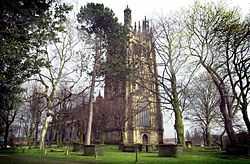
St. Giles is the Parish Church of Wrexham and is considered to be the greatest medieval church in Wales.[19] It includes a colourful ceiling of flying musical angels, two early eagle lecterns, a window by the artist Edward Burne-Jones and the Royal Welch Fusiliers chapel. In the graveyard is the tomb of Elihu Yale who was the benefactor of Yale University in New Haven, Connecticut, United States and after whom Yale College Wrexham is named. As a tribute to Yale and his resting place, a scaled down replica of the church tower, known as Wrexham Tower was constructed at Yale University. The tower appears in an 18th-century rhyme, as one of the Seven Wonders of Wales.
St. Mary's Cathedral

The Catholic Cathedral of Our Lady of Sorrows in Regent Street is the main church of the Diocese of Wrexham, which extends over all of North Wales. Built in 1857 at the height of the Gothic Revival, the cathedral was home to the Bishop of Menevia from 1898 until 1987, whose diocese covered all of Wales. However in 1987 the Catholic province of Wales was reconstructed, since which time the cathedral has been home to the Bishop of Wrexham. The cathedral is also home to the relic of Saint Richard Gwyn, Wrexham's patron saint. He was a Catholic martyr in the 16th century and was hanged, drawn and quartered at Wrexham's Beast Market. He was canonised by Pope Paul VI in 1970.
Other denominations
Wrexham also has a number of non-conformist chapels and churches around the town, including a corps of The Salvation Army. The main Methodist church is Wrexham Methodist church, built in 1971 on the site of the former Brynyfynnon Chapel on Regent Street. Up until the 1970s the town had several Welsh non-conformist chapels and the attendance of these was far in excess of that of the Anglican Church in the town.
There is a mosque located on Grosvenor Road in the former Wrexham Miners' Institute.
In the past, Wrexham had a church with a spire much taller than the St. Giles' church tower. This church was dedicated to and named after St. Mark and located in St. Mark's Road but was demolished in 1960 after being declared unsafe and in danger of collapse due to inadequate foundations. A multi-storey car park named St. Mark's was erected on the site.
Education
Glyndŵr University
Named after the 14th century scholar and last Welsh Prince of Wales, Owain Glyndŵr, Glyndŵr University was formed when the North East Wales Institute (NEWI) was granted full university status in 2008. It consists of Plas Coch campus in the western part of the town and the North Wales School of Art and Design located on Regent Street. The institution was originally founded in 1887 as the Wrexham School of Science and Art.
Glyndŵr remains an accredited institution of the University of Wales and offers both undergraduate and postgraduate degrees. The Vice Chancellor is Professor Michael Scott. Glyndŵr has approximately 8,000 full-time students and over 350 from outside the UK.
Yale College of Wrexham
Yale College / Coleg Iâl is the main provider of adult education in Wrexham and is one of the largest colleges in Wales. As a tertiary college it also provides a wide range of higher education courses at its two campuses at Grove Park in the town centre and Bersham Road in south west Wrexham.
It is named after Elihu Yale, best known for being the prime benefactor of Yale University. It was founded in 1950 as a state school on a site at Crispin Lane. In 1973, as part of the conversion of local schools to the comprehensive system, it was renamed as Yale Sixth Form College and the pupils re-located to other schools. The Crispin Lane site was incorporated into NEWI (now Glyndŵr University) after the development of the Grove Park Campus.
In 1998 Yale College took up residence in two sites across Wrexham: the faculty of engineering and construction at a site on Bersham Road, and a multi purpose site in a redeveloped Grove Park campus. Over the next fifteen years the college grew. In 2013 Yale College was merged with Deeside College, Northope College, and Llysfasi College to form a new college: Coleg Cambria under the leadership of the ex-Deeside Principal Mr David Jones. The merger officially took place on 1 August 2013.
Schools
Wrexham has a number of primary and secondary schools. It has just one Welsh-speaking secondary school, Ysgol Morgan Llwyd. Recently, three of the largest secondary schools, St David's School, Ysgol Bryn Offa and The Groves High School were merged to create two larger "super schools", Rhosnesni High School, and Ysgol Clywedog. Other large secondary schools Darland High School and Ysgol Bryn Alyn, were both built in 1958. Wrexham has become home to the first shared-faith school in Wales, St Joseph's.
Twin municipalities
-
 Iserlohn (Märkischer Kreis), Germany
Iserlohn (Märkischer Kreis), Germany -
 Racibórz, Poland
Racibórz, Poland
The town of Wrexham is twinned with the German district of Märkischer Kreis and the Polish town of Racibórz.
The first twinning was established on 17 March 1970 between the former Kreis Iserlohn and Wrexham Rural District. Its early success ensured that, after local government reorganisation in both countries in the mid-seventies, the twinning was taken over by the new Councils of Märkischer Kreis and Wrexham Maelor Borough Council and, in 1996, by Wrexham County Borough Council.
In 2001 Märkischer Kreis entered a twinning arrangement with Racibórz (Ratibor), a county in Poland, which was formerly part of Silesia, Germany. In September 2002, a delegation from Racibórz visited Wrexham and began initial discussions about possible co-operation which led, eventually, to the signing of Articles of Twinning between Wrexham and Racibórz in March 2004. The Wrexham area has strong historical links with Poland. Following World War II, many service personnel from the Free Polish armed forces who had been injured received treatment at Penley Polish Hospital. Many of their descendants remain in the area to this day.
Transport
Rail
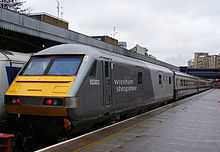
Wrexham has five railway stations, Wrexham General, Wrexham Central, Gwersyllt, Ruabon and Chirk. Until the early 1980s what is now platform 4 of Wrexham General, serving the Wrexham Central – Bidston service, was a separate station, Wrexham Exchange. Rail use is currently expanding rapidly in Wrexham; General has seen a 12% rise in passenger numbers between 2004 and 2007, Central seeing an increase of 18%.[20]
- Wrexham General
Wrexham General was opened in 1846, rebuilt in 1912 and again in 1997. It has six platforms (four through, two terminal) and provides direct rail services to Bidston (for Liverpool Lime Street), Manchester Piccadilly, Bangor, Birmingham, Crewe, Milton Keynes, Rugby, Cardiff, Chester, Holyhead, Shrewsbury, Wolverhampton and London. Wrexham General is on two different lines, The Severn-Dee Main Line and The Borderlands Branch Line. It is also on an extension of the West coast main line towards London via Crewe, Welsh Marches Line services towards both Cardiff and Manchester travel via Wrexham on a regular basis. Wrexham General is the largest station in North Wales and frequency of services is steadily increasing.
Wrexham General was also the base for the train operating company Wrexham & Shropshire (the operating name of the Wrexham, Shropshire and Marylebone Railway Company). The company provided passenger train services from Wrexham via Shropshire to London Marylebone on an open-access basis. Services started in 2008 with an agreement for a seven-year period.[21] Wrexham & Shropshire began running services on 28 April 2008.[22][23] Having decided they could not make the business profitable, the company ended services on 28 January 2011.[24]
All services that operate from Wrexham Central to Bidston also run through this station.
- Wrexham Central
Wrexham Central, which is located on the Island Green retail park, is a small terminus station which is the southern terminus of The Borderlands line. It provides direct rail services to Bidston (where there are connections to Liverpool and West Kirby), Buckley, Caergwrle, Cefn-y-Bedd, Gwersyllt, Hawarden, Hawarden Bridge, Heswall, Hope, Neston, Penyffordd, Shotton and Upton (Wirral). Until the 1998 construction of the Island Green retail park, Wrexham Central station was located 50 metres further along the track.
Plans are afoot to electrify the Borderlands line which runs through General and Central to Deeside and the Wirral. This would increase capacity and accelerate speeds on the line.
- Gwersyllt
Gwersyllt is an unmanned halt which serves the Gwersyllt suburb of Wrexham. It is a stop on the borderlands line between Wrexham General and Bidston.
- Ruabon
Ruabon is a bus and mainline rail interchange located in South Wrexham. It is the second busiest station in Wrexham after Wrexham General. It is located on the Shrewsbury to Wrexham line between Chirk and Wrexham General. It now only has two through platforms, the former bay platforms long disused. The station is easily accessible from Junction 1 of the A483 and has a large free car park where shoppers can park before boarding a bus or train into Wrexham centre. The town centre is approximately 7 minutes away by train and 20 minutes by bus.
Trains run hourly in each direction between Wrexham and Shrewsbury. North bound trains usually continue beyond Wrexham to Chester and Holyhead where as south bound trains usually continue to either Cardiff or Birmingham.
- Chirk
Chirk is a small station that serves the town of Chirk. It is on the Shrewsbury to Wrexham line with an hourly service in each direction weekdays and Saturdays, with a two hourly service on Sundays.
Bus
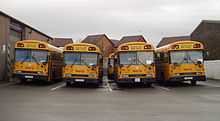
A recent focus on road transport by the council has improved bus travel in the Wrexham area, with most buses being low-floor and with slightly elevated bus stops to allow easier access. A new bus terminal, the largest in north Wales, has been built in Wrexham, with a staffed information booth. The bus station serves local, regional and long-distance bus services. It is served by various bus companies, including Arriva Buses Wales, GHA Coaches and Townlynx. Long-distance coaches are available to Edinburgh via Manchester, Bradford and Leeds and to London via Telford and Birmingham. The Wrexham Shuttle provides a link between Wrexham and the nearby industrial estate. The townlink bus connects the main bus station with Eagles Meadow shopping centre and Border retail park to the east and Wrexham General and Central stations with Plas Coch, Wrexham Central and Island Green shopping centres to the south and west of the town. Wrexham is served by the National Express coach network, which picks up from the Wrexham bus station. Wrexham is one of the first areas in the United Kingdom to adopt the use of the distinctive yellow American Bluebird school buses. Ten currently operate in the Wrexham area, transporting pupils to and from the schools and colleges.
Roads
The town centre is orbited by a ring road. The northern and eastern parts of the road are dualled between Rhosddu Road roundabout and Eagles Meadow. The A483 is Wrexham's principal route. It skirts the western edge of the town, dividing it from the urban villages to the west. The road has connections with major roads (A55(M53), A5(M54)). The A5156 leads to the A534 and on to the Wrexham Industrial Estate. The A541 road is the main route into Wrexham from Mold and the town's western urban area. It connects to the B5101 road which eventually leads to the A5104 road to the east of Treuddyn in Flintshire.
Future development
Wrexham to Chester railway lines are expected to be re-doubled at a cost of £36 million. The works are expected to be completed by early 2015.[25]
Redevelopment of the Kop stand at the Racecourse stadium is expected to proceed in the coming years with the owners of the stadium recruiting a development director named Paul Fletcher to push forward plans for the Kop.[26]
Western Gateway project is a long-term development proposed by the Wrexham council as a third phase of the Wrexham technology park focusing on companies that can help drive the local economy with better paid jobs while focusing on an eco friendly approach from design to construction.[27]
Liverpool donated £100,000 to a study of electrification of the Wrexham to Bidston railway line, and a possible rail link to the North Wales coast line. This would open new rail links to the east, and the urban area of Liverpool. The line was put on indefinite hold following a larger than expected cost projection by Network Rail.[28]
In September 2013 it was announced by the Ministry of Justice that a new 2000 inmate prison will be built on the former Firestone site at the Wrexham Industrial Estate by 2017.[29]
People
- See Category:People from Wrexham
- Sam Snowden – baritone
- Jack Mary Ann – a local folk hero who lived in the Top Boat House area of Broughton
- William Davidson Bissett (1893-1971) - Scots-born Victoria Cross winner. Cremated at Pentre Bychan.
- Hannah Blore- Byte Class; Women's World Champion, 2005, 2008
- David Bower – a deaf actor who is best known for his role as David, the younger brother of Charles, in the comedy Four Weddings and a Funeral.
- Derek Crewe - (1945-2011) Actor, best known for his roles in the television series Z Cars, The Tomorrow People, Doctor Who, Van Der Valk, All Creatures Great And Small and Holby City. Stage work included several seasons at the RSC and Theatre Clwyd.
- Charles Harold Dodd (1884–1973) – eminent New Testament scholar and influential Protestant theologian
- Percy William Dodd (1889–1931) – classics lecturer at the University of Leeds and captain in the West Yorkshire Regiment during the Great War
- Arthur Herbert Dodd (1891–1975) – Welsh historian and professor of history at University College, Bangor
- Samuel Ellis - owner of Ellis Island in New York Harbor
- Stephen Evans (born 1970) - Actor, best known for his regular role as Vine in the BBC sci-fi sitcom Hyperdrive (TV series) alongside Miranda Hart & Nick Frost. He also appeared in Nighty Night, Doctors & My Family. Stephen attended Acton Park Primary School.
- Rosemarie Frankland – beauty pageant contestant who won the 1961 Miss United Kingdom and Miss World.
- Chris Bartley - Olympic silver medallist rower.
- Amy Guy current gladiator 'SIREN' on the TV show of the same name. Member of British Team in horse riding. Miss Wales 2004 Miss World Sport 2004. Miss United Kingdom 2005.
- Saint Richard Gwyn – (1535–1584) – Catholic Martyr and Patron Saint of Wrexham
- Edwin Hughes – ("Balaclava Ned") (1830–1927), the last survivor of the Charge of the Light Brigade at Balaklava in the Crimea
- Mark Hughes – former Welsh international footballer and subsequently manager of several clubs
- Tom James – Olympic Gold Medallist Rower.
- George Jeffreys – (1645–1689) 'The Hanging Judge' of Acton Hall in Acton
- Darren Jeffries – Hollyoaks actor
- Professor Sir Ewart Ray Herbert Jones FRS - chemist, inventor of the Jones oxidation, Waynflete Professor of Chemistry at Oxford University
- Joey Jones – football player who played for Liverpool, Chelsea and Wrexham
- Paul Jones – retired Welsh international footballer.
- Rob Jones – footballer who played for Liverpool F.C.
- K-Klass – dance music group
- Jason Koumas – footballer with Wigan Athletic
- Tom Lawrence - footballer with Manchester United
- David Lord – (1913–1944), Irish born holder of the Victoria Cross and Distinguished Flying Cross.
- Andy Moore – Neath/Swansea Rugby Club & Wales International.
- Seb Morris (Racing Driver)- Also appeared as the face of Jack Wills Autumn/Winter 2013 campaign.
- Jonathon O'Dougherty – British National Ice Dance champion
- John Godfrey Parry-Thomas – (1884–1927), engineer and racing driver.
- Leigh Richmond Roose – Welsh international footballer who played for Stoke City, Sunderland and Celtic amongst others.
- Robbie Savage – former Derby County footballer and Wales international.
- Andrew Scott – guitarist with 70s glam rock band The Sweet
- Dennis Taylor – ex snooker World Champion, currently living in Llay
- Tim Vincent – former Blue Peter presenter, now Access Hollywood reporter.
- Robert Waithman – (1764–1833), born in Wrexham, became Lord Mayor of London in 1823
- John "Iron-Mad" Wilkinson – (1728–1808) Son of Isaac, known for Bersham Ironworks in the town and producing cannons for the American civil war
- Llŷr Williams – Welsh pianist, received the Outstanding Young Artist Award from MIDEM Classique and the International Artist Managers' Association.
- Elihu Yale – (1649–1721), businessman and benefactor of Yale University.
- Philip Yorke (1743-1804), antiquarian and writer, squire of Erddig
- Charlie Landsborough – (born 1941), British country and folk musician and singer-songwriter.
- Dewi Penrhyn Jones - Professional Cricketer for Glamorgan C.C.C.2014. Born in Wrexham 1994
References
- ↑ "WCBC: Welcome to Wrexham – Rich in History". Wrexham.gov.uk. Retrieved 9 February 2012.
- ↑ "Buildings and places of Wrexham past and present". Retrieved 14 November 2014.
- ↑ Durham Mining Museum (photo of memorial) (Retrieved January 2011)
- ↑ "Polish War Graves". www.derekcrowe.com. Retrieved 23 June 2012.
- ↑ Daily Post http://www.dailypost.co.uk/news/north-wales-news/2005/05/23/website-s-a-winner-55578-15548156/
- ↑ SOCITM report 'Local Council Websites: Design by Committee?' http://www.webcredible.co.uk/user-friendly-resources/white-papers/council.pdf
- ↑ Williams, Martin (27 March 2012). "Call to make Wrexham, Deeside and Chester a city region - News - Business - Daily Post North Wales". Dailypost.co.uk. Retrieved 15 June 2012.
- ↑ "Latest Wrexham News – Wrexham entrepreneurs lead the way". Wrexhamtoday.com. 27 January 2012. Retrieved 9 February 2012.
- ↑ "Guinness cheers Racecourse with official record". Daily Post North Wales. 18 June 2008. Retrieved 22 September 2010.
- ↑ National Trust http://www.nationaltrust.org.uk/main/w-vh/w-visits/w-findaplace/w-erddig/w-erddig_development-special/w-erddig_development-faq.htm#whyerddig
- ↑ Rhostyllen.com http://www.rhostyllen.com/home/
- ↑ "Central Station website". Centralstationvenue.com. Retrieved 9 February 2012.
- ↑ "NEWI Student's Union website". Newisu.com. Retrieved 9 February 2012.
- ↑ "Crusaders set for Wrexham move". Superleague.co.uk. Retrieved 9 February 2012.
- ↑ Fields of Praise, The Official History of the Welsh Rugby Union 1881–1981, David Smith, Gareth Williams (1980) pg 271 ISBN 0-7083-0766-3
- ↑ http://www.bbc.co.uk/news/uk-wales-north-east-wales-25298232
- ↑ http://savepmlc.wordpress.com/
- ↑ Envy Largest in North Wales
- ↑ Church Network
- ↑ http://www.dailypost.co.uk/news/north-wales-news/2008/06/28/booming-time-for-the-trains-in-wrexham-55578-21165396|Daily Post – Wrexham sharp increase in rail usage
- ↑ "ORR announces decision on additional services between London and Wrexham" (Press release). Office of Rail Regulation. 3 September 2007. Retrieved 3 September 2007.
- ↑ "Wrexham service to London starts". BBC News. 28 April 2008. Retrieved 18 August 2012.
- ↑ Clinnick, Richard (7–20 May 2008). "40 years on – Wrexham and Shropshire takes to the rails". Rail 591: 6–7.
- ↑ Milmo, Dan (26 January 2011). "Wrexham & Shropshire rail operator shuts after severe losses in profit". The Guardian. Retrieved 18 August 2012.
- ↑ "A £36m Wrexham to Chester rail project is set to cut journey times". BBC News. 19 March 2012.
- ↑ "Glyndwr University appoints new racecourse stadium development director". Glyndwr. 5 December 2012.
- ↑ "– Western Gateway Project". Wrexham.gov.uk. 6 August 2011. Retrieved 9 February 2012.
- ↑ Liverpool Daily Post (5 November 2008). "NETWORK Rail was accused of massively overpricing the cost of electrifying the Bidston to Wrexham railway line because it doesn’t want the work. – Liverpool News – News – Live". Liverpooldailypost.co.uk. Retrieved 9 February 2012.
- ↑ "BBC News - £250m super-prison to be built on ex-Firestone factory land". Bbc.co.uk. Retrieved 4 September 2013.
External links
| Wikimedia Commons has media related to Wrexham (town). |
| Wikivoyage has a travel guide for Wrexham Wrexham. |
- Wrexham County Borough Council
- Wrexham.com
- Evening Leader
- Calon FM – Wrexham Community Radio
- Wrexham Tourism – Trip Advisor
- Local History – Wrexham (BBC)
- The Anglican Parish of Wrexham, including Wrexham Parish Church
- Wrexham Musical Theatre Trust
- Wrexham FC – Wrexham FC Official site
- Wrexhammusic.co.uk – Online hub for music in Wrexham
- Wrexham Arts – An online hub for arts, culture and entertainment in Wrexham
- 360 Degree Panoramic View of Queens Square (BBC) (Java required)
- Francis Frith Historic Photos of Wrexham (mainly from 1895)
| ||||||||||||||||||
| ||||||||||||||||||||||||||||||||||||

